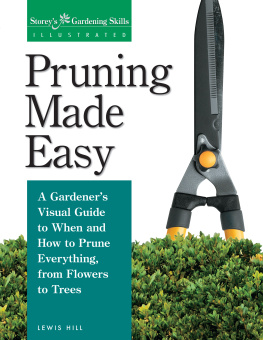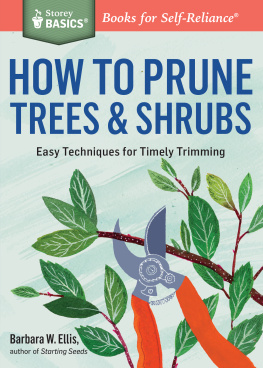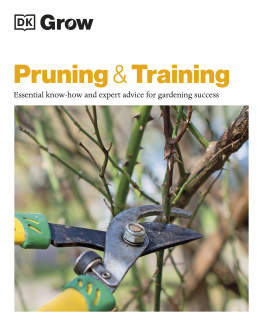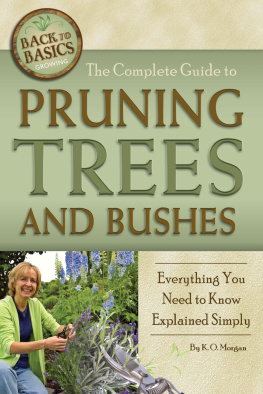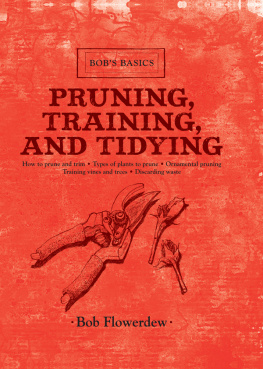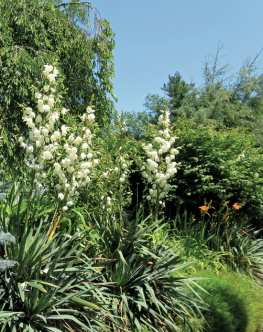Pruning Trees, Shrubs, and Vines
The mission of Storey Publishing is to serve our customers by publishing practical information that encourages personal independence in harmony with the environment.
Cover design by Carol J. Jessop (Black Trout Design)
Cover Illustration by Elayne Sears
This bulletin is an expanded version of How to Prune and Trim by Seymour Smith & Son, Inc.
1980 by Storey Publishing, LLC.
All rights reserved. No part of this bulletin may be reproduced without written permission from the publisher, except by a reviewer who may quote brief passages or reproduce illustrations in a review with appropriate credits; nor may any part of this bulletin be reproduced, stored in a retrieval system, or transmitted in any form or by any means electronic, mechanical, photocopying, recording, or other without written permission from the publisher.
The information in this bulletin is true and complete to the best of our knowledge. All recommendations are made without guarantee on the part of the author or Storey Publishing. The author and publisher disclaim any liability in connection with the use of this information. For additional information please contact Storey Publishing, 210 MASS MoCA Way, North Adams, MA 01247.
Storey books and bulletins are available for special premium and promotional uses and for customized editions. For further information, please call 1-800-793-9396.
Printed in the United States by Walsworth Publishing Company
Pruning trees, shrubs, and vines
A Storey Publishing Bulletin, A-54
ISBN 978-0-88266-229-9
CONTENTS
Introduction
Do you have an old grapevine that needs training? A forsythia that has become too leggy? Have you just purchased a new home and felt mystified by the pruning chores ahead?
The subject of pruning can fill a whole book, and sometimes even the experts disagree over the best practices. But the principles of pruning are simple. This bulletin tells you how to keep your trees, shrubs, and vines attractive and healthy through careful pruning.
What is pruning? It is cutting away unwanted parts of a plant for a better shape or more fruitful growth.
What is involved in pruning? To do the job well, you need to know when (in what season) to prune, what to cut away, and how to do the cutting. For most jobs, all you will need are a few simple hand tools, although power tools are sometimes handy.
Is pruning really necessary? Nature does its own pruning. The woods are full of dead limbs and branches pruned by natures ruthless wind, snow, and ice storms. Weak branches die and drop off neglected trees; rubbing branches kill one another. Thick under-growth frequently kills trees by its dense shade. But, natures pruning is a slow, haphazard process; you can get better results with pruning shears.
There are four basic reasons for pruning. Careful pruning enables you to control the shape and growth of your plant, to increase its productivity through more blooms and larger fruits, and to maintain the health of the plant.
Pruning for Shape and Form. Some pruning is done mainly for appearance. The beauty of conifers, such as fir, spruce, and pine trees lies in their natural shape. But these stiff-needled plants are actually forest trees, and frequently they will ruin the appearance of property by smothering the house, crowding doorways, or blocking off windows. Trees should be controlled by pruning.
With formal foundation plantings, the shrubs or trees are sheared, rather than pruned. Shearing means cutting off the soft new growth to limit the plants growth and to shape it.
Heading back is a term youll hear with respect to pruning for shape. It simply means reducing the size of a plant to encourage denser growth.
Growth Control. A young plant should be pruned to give it a basic structure of good habits and tendencies. In the case of a fruit tree, for example, you want to open up the tree to allow more sunlight to get to the inner branches so fruit can grow and ripen there, as well as on the outer limbs. A tree must be pruned to be strong enough to hold up its fruit load. You also prune to avoid a weak structure, as when a fruit tree develops a crotch that could split.

New trees or shrubs may come in a container, balled and burlapped, or bare-rooted. If bare-rooted, prune back the top (right) to restore balance.
Pruning is necessary when a young tree is transplanted. A growing plant should be able to take up enough moisture through its roots to sustain itself. In transplanting, however, the digging out process frequently disturbs and destroys part of the root growth. Wilting will occur if the moisture given off by the foliage on the top of the plant exceeds the capacity of the roots to supply it. So pruning is done to keep the top growth down to what the roots can support.
Increase Productivity. A tree or bush has just so much energy to expend in producing blooms and fruits. If you thin out extra branches, you will have larger, showier blossoms and bigger fruits. A well-thinned fruit tree is more likely to bear every year, too.
Healthier Plants. Its a drain on the energy of any plant to support dead limbs and broken or diseased branches. These should come off promptly. A dead branch offers an opportunity for insects and rot organisms to enter.
When should you prune? When to prune depends on many things. First, it depends on the plant. Trees are usually pruned while they are dormant. If pruned in the spring or even late winter certain trees will bleed too much sap; others, if pruned in the summer or early fall, may develop new soft growth that will not withstand the winter. For these same reasons, grapevines are also pruned while dormant. Hedges, on the other hand, are trimmed several times a growing season to stimulate denser growth.
There are no absolute rules to follow. Many growers prefer to prune heavy bleeders maples and birches late in the summer. In areas where the winter is not severe, fall pruning may not lead to growth that can be winter-killed as it would in northern areas.
The growth habit of the plant is an important consideration. With flowering shrubs, you need to know whether blooms are produced on year-old growth or on new growth. Early spring pruning stimulates growth for shrubs that will bloom on the new shoots; but pruning after flowering is best for shrubs like forsythia that bloom on year-old wood.
Any time is a good time to prune away dead growth or broken or diseased limbs. Feel free to snip away water sprouts or remove suckers as they appear. Undesired growth drains energy from the plant.
The Basics
The mistake that many home growers make is usually either too little or too much pruning. The extent to which a plant needs to be pruned depends on the habits of the species and also on how old the plant is. A young tree, vine, or shrub will need more formative pruning to get it off to a good shape. Many ornamental trees and vines can be left pretty much alone once they have matured.
Check the table in the back of this bulletin for the special pruning requirements of many commonly grown plants. Always keep in mind to what purpose you are training your plant as a privacy hedge or fruit-bearing tree, for example and let your common sense guide you.
Tools
There is a large assortment of pruning equipment on the market, and only trial and error will enable you to find the tools you like to work with best. But a few hand tools will get you started.


